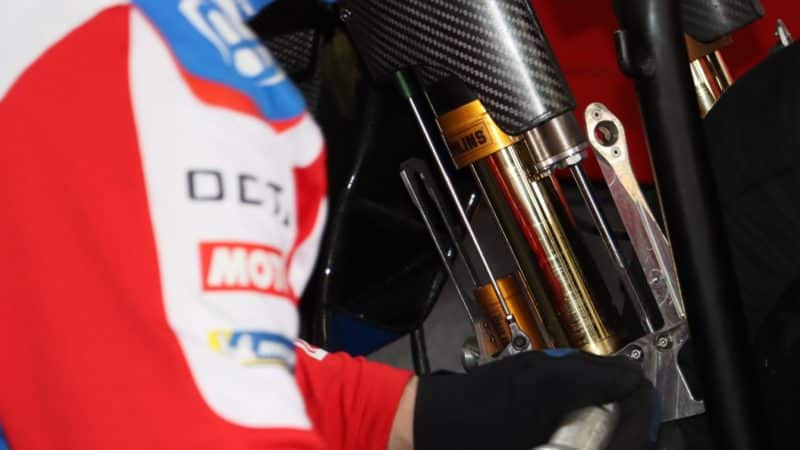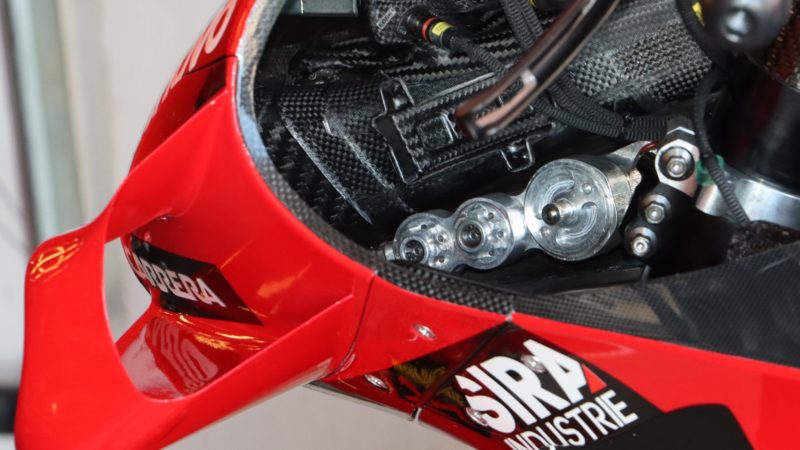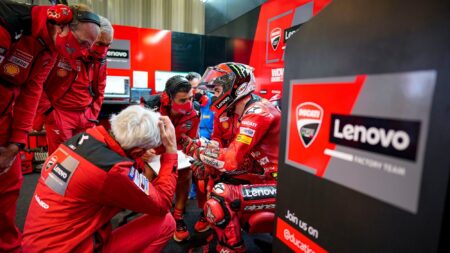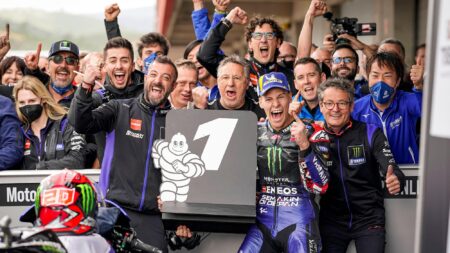But after speaking to engineers from both MotoGP and Formula 1, this is what it seems to be…
Ducati’s actuator features three cylinders, CNC’d from aluminium alloy. The largest, right-hand cylinder is a hydro-pneumatic (air-over-oil) separation cylinder, with air and oil separated by a piston and topped by a Schrader valve.
Why air over oil? Because controlling the hydraulics with pneumatics allows the generation of much higher hydraulic pressure. These hydraulic systems run at massive pressures – over 100 bar or 1500 psi – to raise and lower the rear end of the motorcycle.
When Miller hits the shapeshifter switch (borrowed from a mountain bike – where shapeshifter technology has been used for years) on the left handlebar of his GP22 the piston moves down the cylinder, increasing hydraulic pressure to compress the rear shock, dropping the rear of the bike to lower the centre of mass, reduce wheelies and thereby increase acceleration. When he hits the switch again the piston moves up the cylinder, the shock extends and the rear lifts.

The F1-inspired accumulator system that’s currently fitted to all GP22 machines
Mat Oxley
But why is the unit fitted at the front of the bike when it’s operating the rear shapeshifter? Most likely packaging. Either Ducati has run out of room at the rear of Miller’s bike, or it wants to change overall balance with more weight up front. On the other hand, perhaps team-mate Pecco Bagnaia has the same unit hidden somewhere at the rear of the bike. It’s impossible to know. Obviously, wherever the unit is situated, long, high-pressure hydraulic lines are required, running between the left handlebar, the unit and the rear shock.
The centre and left-hand cylinders of the shapeshifter actuator control the flow of hydraulic oil, to regulate the speed at which the motorcycle rises and drops. Obviously, it’s vital that the rear moves smoothly and at precisely the rate the rider prefers.
Ducati Corse general manager Gigi Dall’Igna got the idea for MotoGP shapeshifters in June 2019, after factory rider Andrea Dovizioso raced an Audi in the DTM championship at Misano. The pair were chatting about the race and Dovizioso told Dall’Igna about the mechanical switch he used to actuate a water spray to cool the brakes.
If a driver can use a switch to improve performance during a race, why can’t a rider adjust the motorcycle’s suspension during a race, to reduce wheelies exiting corners, just as a holeshot device reduces wheelies at the start? A few months later the first shapeshifter appeared in MotoGP.
What adds some confusion to what’s going on with Miller’s bike is that it still runs the accumulator in the right side of the fairing. This is an F1-inspired device, based on the system that allowed drivers to adjust the car’s ride height during a race as fuel load decreased. But obviously it’s impossible to know which units are hooked up on Miller’s bike and which aren’t.

The front shapeshifter on Zarco’s GP22. Its hydraulic control sits in front of the right fork leg. Behind the fork is the suspension stroke sensor
Mat Oxley
While Miller has both these units fitted to his bikes he definitely doesn’t have the front shapeshifter, which the factory team used in pre-season but then discarded. This system is easy to spot, because it features a hydraulic unit – similar to a steering damper – in front of the right fork leg, usually hidden from view by a special fender.
Zarco likes the system and it’s getting better with every race. The Frenchman scored the front shapeshifter’s first pole position and podium at last weekend’s Portuguese GP, so it’s obviously already working well and will surely only get better, even if front shapeshifters will be banned at the end of this season.




